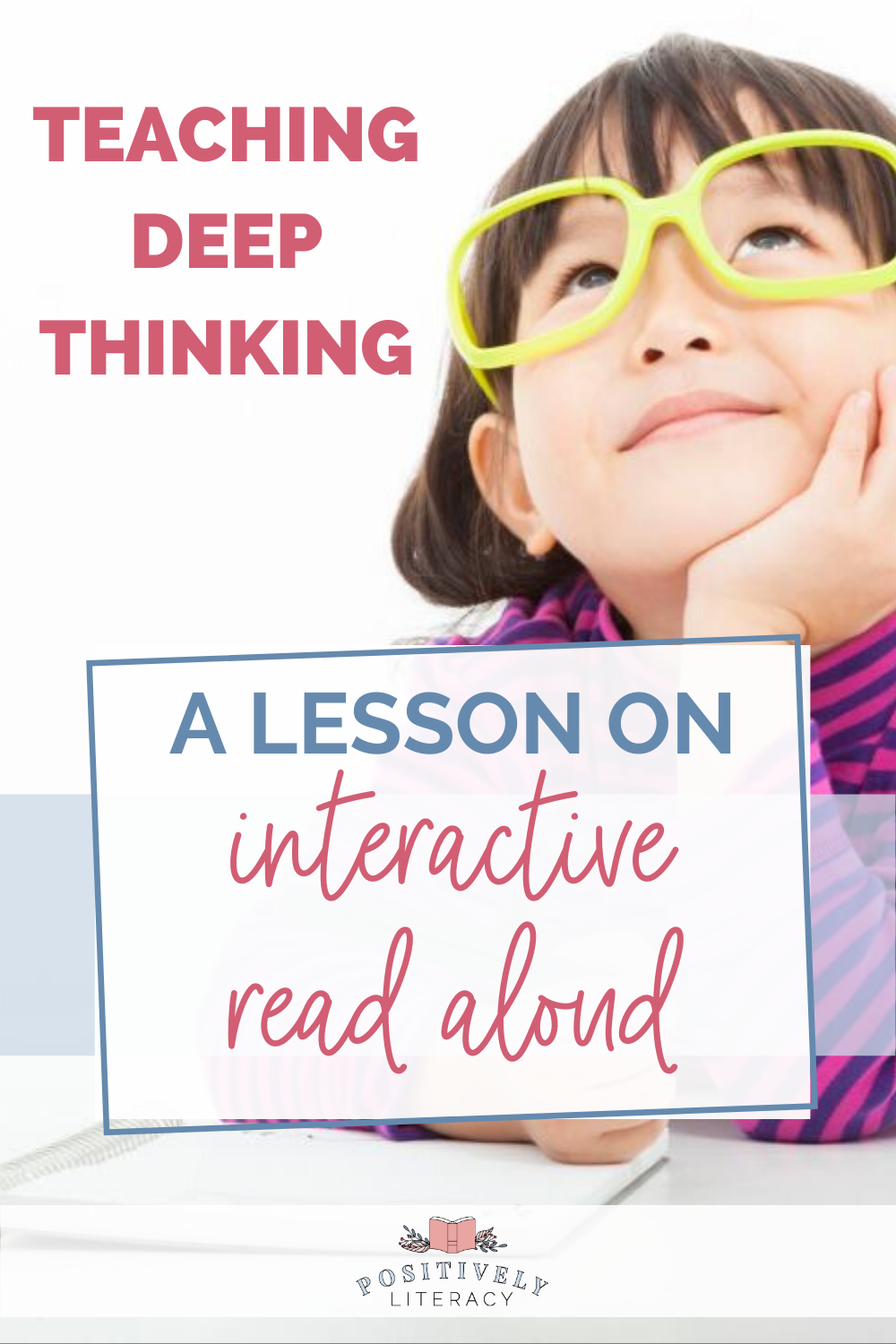Teaching Deep Thinking with Interactive Read Alouds
What comes to mind when you think of the term read aloud? Is it that precious few minutes after lunch when your teacher read a chapter from the latest Beverly Cleary book? Is it Saturday mornings at the public library listening to the librarian bring a book to life? Is it the time you spent sitting in the recliner with your granny while she read your favorite book just one more time?
"As we share the words and pictures, the ideas and viewpoints, the rhythms and rhymes, the pain and comfort, and the hopes and fears and big issues of life that we encounter together in the pages of a book, we connect through minds and hearts with our children and bond closely in a secret society associated with the books we have shared. The fire of literacy is created by the emotional sparks between a child, a book, and the person reading." ---MEM FOX
Let me scream it from the rooftops…Reading aloud to students is not a waste of time. As teachers, we all know the value of reading aloud to our students. We’ve all been a part of the magic that was created when you read that one special book. We’ve felt the tug on our hearts when our kids beg for just one more page.
Yet, the demands for higher test scores, the focus on test prep, and the infiltration of scripted curriculum has crushed read aloud in far too many classrooms because the feels they just don’t have time.
Teachers, I want to remind you that we are all PROFESSIONALS who know what is best for our students. I encourage you to have the courage to put your professional judgement to use and do what you know is good and right for your students. I encourage you to read aloud to your students each and every day without feeling guilty or the need to justify the use of precious instructional minutes to read aloud to your students.
Of course, the primary goal of reading aloud is for your students to fall in love with books and reading. However, reading aloud to your students is the perfect opportunity to model higher level thinking skills that students will need to engage with more challenging texts.
Of course we want kids to love books….so grabbing their attention before beginning a book is important. There are several ways to introduce a book before reading aloud for you to choose from based on the book, your personality, and the needs of your kids. Here a few of my favorite ways to introduce a picture book before reading it aloud.
Picture Walk: A picture walk is a shared activity between the students and teacher. With a picture walk, the teacher guides the students to look at the illustration on the cover and throughout the book prior to reading the story. The picture walk can give clues to support understanding of unfamiliar words and the meaning of the text.
Book Talk/Commercial: Think of a book talk as a 30 second one shot attempt to catch your students attention and hook them into listening to the read aloud. During a book talk you might give hints or clues about the plot, characters, or theme of the book. However, you don’t want to summarize the whole book and you certainly don’t want to give away the ending….No Spoilers Allowed Here!
Author/Illustrator Spotlight: With an author spotlight, you will might want to share with students other books the author wrote that they might be familiar with. This will prompt the students to notice similarities with the author’s works. During an author spotlight, you might also share an interesting fact or two about the author’s life or something unique about their style.
Theme/Topic/Strategy Introduction: The book introduction time can also be used to highlight a specific theme, topic, or strategy that you will be using the mentor text to teach about.
Picture Walk: Meanwhile is such a great mentor text that it would facilitate the use of any of the above ways to introduce a picture book. A quick picture walk through the book will show students how dramatic and comic book like the illustrations are….I promise you that kids will love the illustrations in this book.
Author/Illustrator Spotlight: Once the kids are drawn into the illustrations, I like to share a few facts about the author/illustrator. In addition to writing and illustrating fun picture books for kids, Jules Feiffer is a distinguished cartoonist. He has one the Pulitzer Prize for his editorial cartoons and has been inducted into the Comic Book Hall of Fame.
Strategy Introduction: When I use this book in my class, I usually focus on its use of the transition “meanwhile”. I want my kids to understand that transition words are used to help connect ideas, phrases, sentence, or paragraphs. Transitions help the read move through the text smoothly by linking or bridging different ideas in the text. Without transitions, it is likely the text would be choppy and hard for the reader to follow because they would be jumping from one idea to the next.
Introducing Parallel Plot: One of my favorite ways to introduce parallel plots that support the use of the transition “meanwhile” is using Pixar Shorts. I specifically like the Partysaurus Rex Short that you can watch HERE or HERE.
This book is great for teaching transitions with its focus on “meanwhile” as a tradition. If you are working with younger students in grades K-2 it is probably best to introduce the concept of transitions before reading this book because the transition “meanwhile” has a very specific purpose. We want kids to know that the purpose of any transitional phrase is to move the reader smoothly through the story.
Because it is so specific, kids need to have an understanding of its purpose and when to use it (and when not to use it). Kids are used to hearing transitions being used to move through a sequence of events….think first, last, then, finally. With “meanwhile” the events are happening at the same time and this is the only scenario where “meanwhile” would make sense.
While the use of the transition “meanwhile” will be the focus of my lesson, the beauty of interactive read alouds is that almost every single standard can be taught with a picture book! You can make the most of your precious instructional minutes by using engaging children’s literature (such as Meanwhile) to teach specific standards and build comprehension.
Interactive read alouds are most successful when you plan your questions around specific comprehension skills. The most effective way to teach kids to comprehend is to give them frequent opportunities to hear their teacher model purposeful thinking using think alouds followed by responding and discussing the strategy with their peers.
You can download the complete set of Interactive Read Aloud Talking Points below, but here’s a glimpse of the standards that can be taught with Meanwhile.
Standards to Teach with Meanwhile
Prediction (pages 1, 8, 14, 22, and 24)
Making Connections (page 2)
Text Structure (page 3)
Transition Words (page 3)
Author’s Craft (pages 4 and 18)
Inference (pages 10 and 14)
Character’s Actions (page 10)
Author's Purpose (page 26)
Since the key focus of this interactive read aloud is the transition “meanwhile”, we are going to guide the kids to map the story showing how “meanwhile” connects the plot. This book has four distinct settings (Raymond’s home, on the pirate ship, the Old West, and outer space) and story lines that the kids will be able to see as they create the story map.
Sign up below and I’ll send you the complete interactive read aloud lesson for the mentor text Meanwhile and the corresponding student response sheet.
Because “meanwhile” is such a specific transition that only works with certain plot structures, it is likely that your kids will need to see more examples of “meanwhile” in use before they are ready to try it out on their own. Here is a list of a few of my favorite books that have a parallel plot structure and make use of the word “meanwhile as a transition.
CHECK OUT THESE MENTOR TEXTS ON AMAZON






